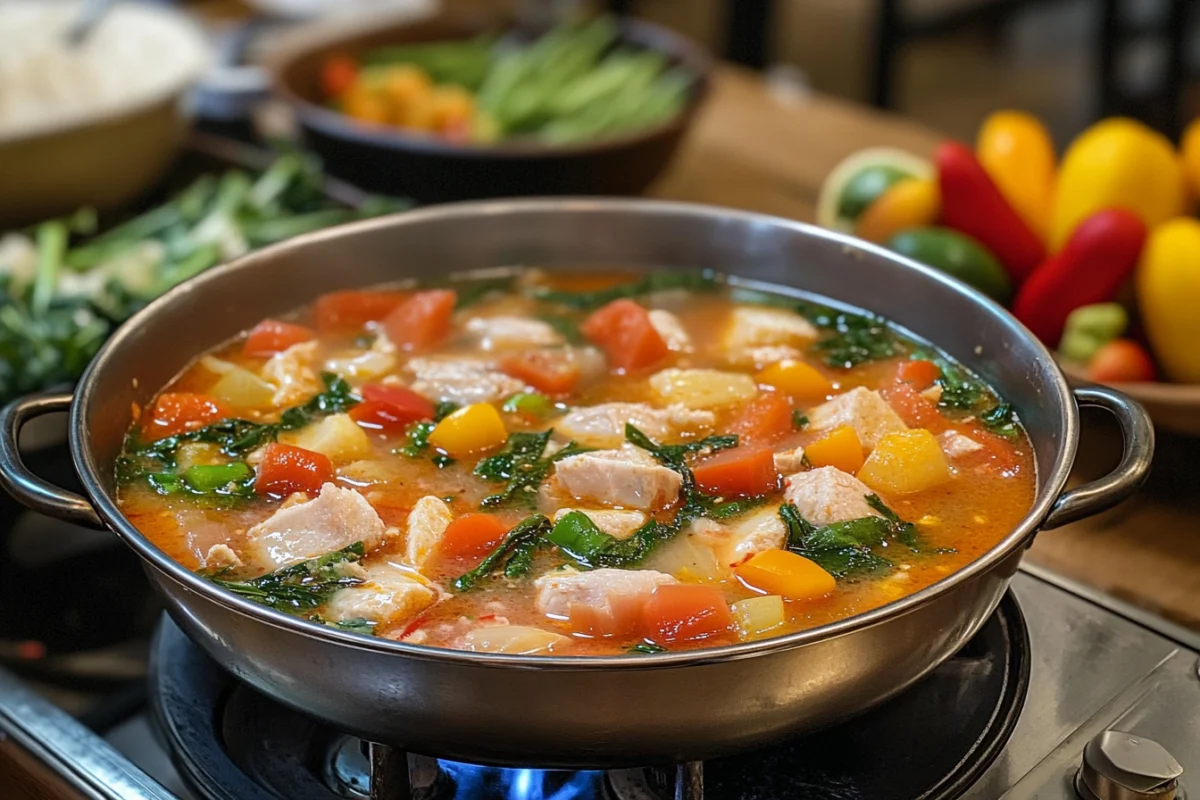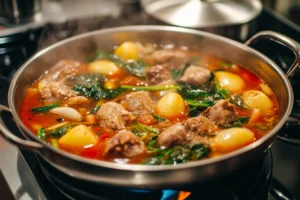Discover the essential ingredients of sinigang and how they create this beloved Filipino soup.
Introduction
Sinigang is a quintessential Filipino soup known for its tangy and savory flavors. Understanding what ingredients of sinigang are mentioned in the selection is key to mastering this delightful dish.
Understanding Sinigang
History of Sinigang
Sinigang holds a special place in Filipino culture, with its origins tracing back to indigenous cooking practices. Traditionally, it was a method to preserve vegetables and meat in a sour broth, ensuring sustenance during dry seasons. Over time, sinigang evolved into a beloved dish celebrated for its unique combination of sourness and savoriness.
Regional Variations
The Philippines’ diverse regions have their unique takes on sinigang, each incorporating local ingredients and flavors. For instance, in some areas, tamarind serves as the primary souring agent, while others might prefer green mango or calamansi for a different tang. Coastal regions often use a variety of seafood, whereas inland areas might favor beef. These regional adaptations highlight sinigang’s versatility and its ability to reflect the local palate.
Essential Ingredients of Sinigang
When exploring what ingredients of sinigang are mentioned in the selection, it’s important to categorize them into proteins, vegetables, souring agents, and seasonings.
Protein Options
- Fish: Commonly used varieties include bangus (milkfish) and tilapia.
- Shrimp: Adds a sweet and delicate taste.
- Beef: Provides a robust flavor profile.
- Chicken: A lighter alternative that still delivers substantial flavor.
Vegetables
- Radish: Adds a mild peppery flavor.
- Eggplant: Absorbs the broth’s flavors beautifully.
- Tomatoes: Introduce acidity and sweetness.
- Okra: Contributes a unique texture.
- Spinach or Kang Kong (Water Spinach): For added greenery and nutrients.
- String Beans: Provide a crunchy texture and vibrant color.
- Taro: Adds a starchy component, thickening the broth slightly.
Souring Agents
- Tamarind Paste: The most traditional souring agent.
- Green Mango: Offers a fruity tang.
- Calamansi: Provides a citrusy sourness.
- Guava: Adds a subtle sweetness to the sourness.
- Kamias (Bilimbi): Known for its intense sour flavor.
Seasonings and Spices
- Fish Sauce (Patis): Enhances the umami flavor.
- Salt: For basic seasoning.
- Pepper: Adds a hint of spice.
- Onions and Garlic: Form the aromatic base of the soup.
- Bay Leaves: Introduce a subtle herbal note.
- Green Chilies: For those who prefer a spicy kick.
Detailed Breakdown of Ingredients
Meats and Seafood
Understanding what ingredients of sinigang are mentioned in the selection regarding proteins is crucial. Beef is the cornerstone, often using cuts like belly or ribs for their flavor and tenderness. Fish options like bangus bring a different dimension, offering a lighter and flakier texture. Shrimp adds a sweet and delicate taste, while beef provides a robust and hearty flavor. Chicken, on the other hand, serves as a versatile and lean protein option that absorbs the soup’s flavors beautifully.
When selecting meats, the quality and freshness are paramount. Fresh, high-quality proteins ensure that the sinigang retains its authentic taste and texture. For seafood-based sinigang, using freshly caught fish or shrimp enhances the overall flavor profile.
Vegetables
The selection includes a variety of vegetables that not only provide nutrition but also balance the flavors. Radish and eggplant are staples, each contributing to the texture and taste. Tomatoes add a necessary acidity, while okra and leafy greens like spinach round out the vegetable component. String beans offer a crunchy texture, and taro adds a starchy element that thickens the broth slightly.
Choosing fresh vegetables is essential. Fresh produce ensures that the vegetables maintain their integrity during cooking, preventing them from becoming mushy and ensuring they absorb the broth’s flavors effectively. Seasonal vegetables also enhance the dish’s taste, providing the best possible flavors and textures.
Souring Agents
Sinigang’s signature tang comes from its souring agents. Tamarind paste is the most authentic choice, offering a deep and rich sourness. Green mango and calamansi provide regional twists, each introducing their unique tang. Guava adds a subtle sweetness to the sourness, balancing the overall flavor. Kamias (bilimbi) is another option known for its intense sour flavor, perfect for those who prefer a more pronounced tang.
The choice of souring agent can significantly impact the soup’s flavor. Tamarind is traditional and widely used, but experimenting with different souring agents can lead to delightful variations. It’s essential to adjust the quantity based on the potency of the souring agent to achieve the desired level of tanginess.
Additional Flavor Enhancers
Beyond the main ingredients, sinigang often includes fish sauce and other seasonings that deepen the soup’s flavor. Fish sauce (patis) is a staple in Filipino cooking, providing a salty and umami-rich taste that enhances the overall flavor profile. Additional seasonings like bay leaves and green chilies introduce subtle herbal and spicy notes, adding complexity to the dish.
These flavor enhancers are essential in achieving the perfect balance of sour, salty, and savory notes. They elevate the soup from a simple broth to a rich and flavorful dish that satisfies the palate.
Preparation Steps
Preparing the Broth
Start by sautéing onions and garlic until fragrant. This aromatic base is crucial for developing the soup’s depth of flavor. Add water or stock to create the base of the broth. Incorporate the souring agent of your choice to infuse the desired tanginess. For example, if using tamarind paste, dissolve it in the broth to ensure even distribution.
In addition, adding bay leaves during this stage can introduce a subtle herbal note, enhancing the overall flavor. Bringing the broth to a boil allows the flavors to meld together, creating a rich and savory foundation for the sinigang.
Cooking the Protein
Introduce your chosen protein into the broth. If using beef, ensure it is simmered until tender, which can take anywhere from 45 minutes to an hour depending on the cut. For fish and shrimp, add them later to prevent overcooking, typically during the last 10-15 minutes of cooking.
Cooking the protein properly is essential for achieving the desired texture and flavor. Overcooking can result in tough meat or rubbery seafood, while undercooking can leave the protein raw and unappetizing. Therefore, it’s important to monitor the cooking process closely.
Adding Vegetables
Once the protein is nearly cooked, add the vegetables. Begin with harder vegetables like radish and eggplant, allowing them to soften without disintegrating. Follow with quicker-cooking vegetables like spinach and string beans. This staged addition ensures that each vegetable retains its texture and contributes appropriately to the soup’s overall composition.
Adding vegetables at the right time is crucial for maintaining their integrity and ensuring they absorb the broth’s flavors without becoming mushy. It’s also an opportunity to adjust the seasoning and sourness as you add more ingredients.
Final Seasoning
Adjust the seasoning with fish sauce, salt, and pepper. Taste and tweak the sourness by adding more souring agent if necessary. This final seasoning step allows you to fine-tune the soup’s flavor, ensuring it meets your personal preference for tanginess, saltiness, and overall taste balance.
Incorporating green chilies at this stage can add a spicy kick for those who enjoy heat in their sinigang. Stirring the soup well ensures that all seasonings are evenly distributed, resulting in a harmonious and flavorful dish.
Tips for the Perfect Sinigang
Balancing Flavors
Achieving the right balance between sour, salty, and savory is key. Start with small amounts of seasonings and adjust gradually to prevent overpowering any single flavor. Taste frequently throughout the cooking process to ensure that the flavors meld harmoniously.
Additionally, consider the intensity of your souring agent. For instance, tamarind paste has a different sour profile compared to green mango, so adjust the quantity accordingly. Balancing flavors ensures that the sinigang is both satisfying and well-rounded.
Choosing Fresh Ingredients
Fresh vegetables and high-quality proteins enhance the overall flavor of sinigang. Opt for seasonal produce for the best taste and texture. Fresh ingredients not only improve the soup’s flavor but also contribute to its nutritional value.
When selecting proteins, choose cuts that are tender and flavorful. For seafood, ensure that it is fresh and free from any strong fishy odors. Fresh ingredients make a significant difference in the final outcome of your sinigang.
Adjusting Sourness
Customize the sourness to your preference. If you prefer a milder taste, use less of the souring agent, or vice versa. It’s essential to add the souring agent gradually, tasting as you go to achieve the desired level of tanginess without overpowering the other flavors.
Experimenting with different souring agents can also help you find the perfect balance. For example, combining tamarind paste with a hint of calamansi can create a complex and nuanced sourness that enhances the soup’s overall flavor.
Health Benefits of Sinigang
Nutritional Value
Sinigang is packed with vitamins and minerals from its diverse range of vegetables. Radish provides vitamin C and fiber, while spinach offers iron and calcium. The lean proteins contribute essential amino acids necessary for muscle growth and repair. Additionally, tomatoes add antioxidants like lycopene, which are beneficial for heart health.
The combination of proteins and vegetables makes sinigang a well-rounded and nutritious meal. It’s an excellent choice for those seeking a healthy and satisfying soup that supports overall well-being.
Digestive Benefits
The sourness from ingredients like tamarind aids in digestion and can help alleviate stomach discomfort. Sour soups like sinigang stimulate the production of digestive enzymes, promoting better digestion and nutrient absorption.
Moreover, the broth’s hydrating properties help maintain fluid balance in the body, supporting overall digestive health. Consuming sinigang regularly can contribute to a healthy digestive system and prevent common digestive issues.
Frequently Asked Questions
What is sinigang made of?
Sinigang is made of a combination of proteins (such as beef, fish, or shrimp), vegetables (like radish, eggplant, and spinach), souring agents (such as tamarind or green mango), and seasonings including fish sauce and spices.
Is Filipino sinigang healthy?
Yes, Filipino sinigang is considered healthy as it contains a variety of vegetables, lean proteins, and is generally low in fat. The broth is also hydrating and can be beneficial for digestion.
How to cook sinigang step by step brainly?
To cook sinigang step by step:
- Sauté onions and garlic in a pot.
- Add water or stock and bring to a boil.
- Incorporate the souring agent.
- Add the protein and simmer until tender.
- Introduce vegetables starting with harder ones.
- Season with fish sauce, salt, and pepper.
- Adjust sourness to taste and serve hot.
What ingredients of sinigang are mentioned in the selection?
The ingredients mentioned in the selection include proteins like beef, fish, and shrimp; vegetables such as radish, eggplant, and spinach; souring agents like tamarind and green mango; and seasonings including fish sauce, salt, and pepper.
Conclusion
Understanding what ingredients of sinigang are mentioned in the selection allows you to create an authentic and flavorful dish. Whether you prefer beef, fish, or shrimp, and choose from various vegetables and souring agents, sinigang is a versatile and delicious soup that brings comfort and satisfaction. By selecting fresh ingredients and balancing the flavors carefully, you can master this beloved Filipino soup and enjoy its rich, tangy goodness anytime.
To learn more about the health benefits of sinigang, check out our article, Is Filipino Sinigang Healthy?.



